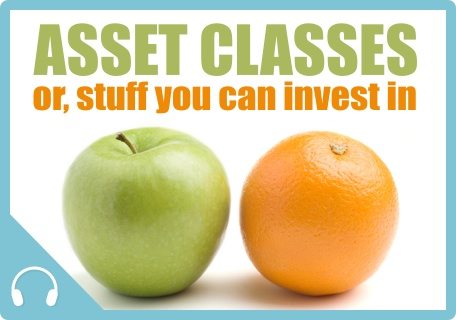Introduction
 What I wanted to cover in this session is to summarise all the major ‘things' you can invest in. We had a brief introduction to investing in my interview with Justin Urquhart Stewart in Session 6, but I want to put some meat on the bones in this session. We'll look at all the major asset classes, how they work, what they're used for etc, then look at what to do with that information!
What I wanted to cover in this session is to summarise all the major ‘things' you can invest in. We had a brief introduction to investing in my interview with Justin Urquhart Stewart in Session 6, but I want to put some meat on the bones in this session. We'll look at all the major asset classes, how they work, what they're used for etc, then look at what to do with that information!
Remember, there are no get rich quick schemes here. Instead I show you in the podcast and all the videos on my site (278 and counting) how to build your future wealth using basic financial planning methods.
Click to Listen
Podcast: Subscribe in iTunes | Play in new window | Download
Everything you need to KNOW
So, let's deal with everything you need to know about the different asset classes:
1 – Cash
Cash is not an investment, it's a place to hold money for the short term, for example if you are saving up for a holiday or a new car. It should NOT be a large part of a portfolio for most people.
That said, it will always form a small part, for two reasons:
- Fund managers almost always hold some cash so that they can jump on buying opportunities
- Also, they may use it as a defensive position in rocky times
How much cash should you hold in your long term investments? At most 1-2%.
2 – Gilts and Corporate Bonds
Gilts and Corporate Bonds are collectively called fixed interest investments – see video Episodes 29 and 30 for video explanations. That phrase ‘Fixed interest' is correct, but can be misleading, because these are nothing like fixed interest accounts in a bank.
Instead they are IOUs.
Gilts are loans to HM Treasury (In the US these are called Treasury Bills or T-Bills). When the government needs to spend more money than they are bringing in in tax, they borrow the money using Gilts
Imagine I lend £100 to the UK government. I now have a piece of paper with three pieces of information on it:
- Amount owed – £100
- Redemption date – 2023
- Coupon (Interest Rate) – 10%
In this case I get £10 per year until 2023, when I get my money back. So far so easy.
But imagine there's a pension manager who needs to secure £10 per year of income for one of his pensioners. He may buy my IOU off me for £200 – this is an extreme example for clarity!
The treasury now owes him, as the holder of that piece of paper, but the piece of paper still has £100 written on it, even though he's paid me £200 for it! The £10 per year interest/coupon is now 5% of the amount he paid for it – this is the running yield.
In 2023 he'll get £100 back from the government and will have lost £100 capital. He will need to factor this loss into his calculations of what to pay me for the IOU – this is called the redemption yield.
Corporate bonds work much the same way but are loans to companies rather than governments. Big companies are very likely to be able to pay the money back, and so are considered to be low risk. We call these investment grade bonds
Smaller companies have a higher chance of going bust, so they need to pay a higher rate of interest to attract lenders. We call these high-yield or sub-investment grade bonds. the worst of these are colloquially called junk bonds.
Fixed Interest assets tend to behave differently to shares; they are generally less volatile. But the lower down the quality scale you go, the more like shares they behave.
3 – Shares
Also called equities, most people know what a share is. A share is a tiny slice of a company which gives you certain rights, e.g.
- To vote on company matters
- To receive a dividend if the company makes a profit
Like most things, shares are valued based on sentiment – see Episode 31 where I demonstrate this using a stick! Shares can be volatile, and if the company goes bust, you can lose the lot.
Shares traded on share markets like the London Stock Exchange. And they are often grouped together in indexes like the FTSE100, which is an index of the 100 biggest companies listed in the UK.
4 – Property
Most people understand property better than any other asset class because most of us live in a property! There is a distinction between residential property like houses and flats, and commercial property like shopping malls and office blocks.
People hold property as in investment in the form of buy-to-let houses and flats, rented out to tenants. This produces an income and in time, hopefully the value will rise too.
Property investment funds tend to hold commercial property like malls and office buildings, rather than residential property.
Property tends to be illiquid, by which I mean it can be difficult to sell quickly and realise the value of it. Contrary to popular opinion, property values do not only go up, they can fall in value too, like most other investments.
Listen to The Property Podcast for great info on this (See the Resources section at the bottom of this post) and listen out for my own session with the two Robs from that show very soon.
5 – Commodities
These are things that we consume as humans, for example:
- Metals like Gold, Silver, Copper, Iron
- Oil and gas
- Soft commodities like wheat and sugar
All these are bought and sold on the world markets and prices can rise and fall. For example, a poor harvest might drive up food prices. Or, an explosion at a major oil refinery will do the same for petrol.
Commodities tend to behave differently to anything else, making them an important part of any investment portfolio.
6 – Gold
We all know what Gold is; it's a yellow metal! There's a finite supply and it is expensive to get out of the ground. And yet something in us is tuned to find gold attractive.
It might be because Gold is tangible; we know what it looks like and feels like to wear it. A corporate bond say, doesn't look so good around our wrist!
But Gold doesn't produce an income like shares and corporate bonds and it therefore has only one string to its investment bow: the capital value. Gold is very volatile. People tend to buy it when share markets are struggling, or when inflation threatens. It should form a small part of most long term portfolios.
7 – Hedge Funds
Hedge funds are designed to do well in a falling market. But how does that work? Surely if markets are going down, everyone loses money?
Here's how it works:
- I'm a hedge fund manager; you have some shares and I think those shares are going to go down in value
- I borrow your shares and pay you a fee for doing so
- I sell the shares in the market, let's say for £1 each
- The shares do go down in value to 80p each
- I buy them back, return them to you and make 20p per share, less any fees
This is a high risk strategy; you are essentially betting on the market. If the market rises though, I have to buy the shares back for more than I sold them for, so I lose money.
Hedge funds were blamed in part for sending the market downwards in 2008/9. I think that was a bit unfair; there was certainly more to the market crash than that.
Generally, you need big money to access Hedge Funds, say in the hundereds of thousands of pounds.
8 – The rest
Private Equity – these are investments in small or startup companies. As such they are very risky; maybe one in ten investments will pay off
Timber – It's wood! It's a commodity of course, but is unique in that it tends to be closely correlated to the US housing market – most houses there are made of wood, apparently.
Infrastructure – Toll-roads, airports, bridges, mobile phone and internet networks – all the things that the human race needs to function in the 21st Century. Companies who provide and build these things are a kind of sub-asset class in their own right.
—
So that's how all the major asset classes work, at least in summary. All these things behave differently to each other for the most part. This is important to remember when building a portfolio.
Everything you need to DO
So, armed with the knowledge of how the major asset classes work, what should you do with that information?
1 – Know your risk profile, and the risks of each kind of asset
I'm going to be doing a session on risk pretty soon – watch (listen to!) this space…
Risk is a big subject with many angles to it, but right now, you want to know whether and by how much the value of an investment might drop in any one year. You should also know its potential upside.
Very quickly, for the purposes of this session, you can manage risk in four ways:
- Time in the market – any investments where the value can go down and up should be held for 5-7 years or longer
- Spreading the money around – diversification into different kinds of assets which behave differently
- Reviewing the portfolio regularly – any investment left to its own devices will underperform over time
- Keep costs down – in these days of lower returns, every pound paid to a fund manager or adviser is a pound not invested
Notice I said these are ways to manage risk, not reduce it. There are many variables and uncertainties with investing.
I would say this I know, but an adviser is best placed to help you manage and assess the risk of your investments.There are certain funds are set up to do this on auto-pilot. We will be talking more about this next time.
2 – Start your investment journey with a blended, multi-asset fund
Justin Urquhart Stewart suggested this in my interview with him in session 6. Even though you now know the basics of how each asset class works, most ordinary people are not qualified to decide which asset classes to invest in from the outset.
A better idea is to find a fund or funds that invest across all or most of them. When blended together, the asset classes can be risk-targeted. Fund managers who build investment portfolios know how these asset classes behave, and can get the weights right between them all to create a fund which has a given level of risk.
Obviously I can't suggest particular funds here or else I'll fall foul of the regulator!
3 – Seek advice, or be prepared to do lots of homework
Pretty lame I know, to suggest you seek advice, but advisers do this stuff day in, day out, and can add serious value to your wealth if you find a good one.
But if you're determined to do it yourself, be prepared to do some homework. Read magazines, do research.
There are many self-directed (that is, no advice is given, you make your own investment decisions) investment platforms out there which offer excellent research tools. One new platform called IC Direct (which I use myself). It includes something called Fundbuzz where you can share the portfolios you have created with other users of the platform and get their feedback and comments. This is a kind of social online investing.
Remember if you do it yourself, there's only yourself to blame if it goes wrong!
4 – Remember investing should be boring
If it is too exciting, it's more like gambling, and I don't want to gamble my pension. Get rich quick schemes too often lead to ‘investors' getting poor more quickly.
Summary
That's a broad outline for you; I'll be adding more next time when I'll be covering the mechanism for investing in these asset classes: Different types of funds, wrappers and platforms – all will be explained!
That's it for this session of the MM podcast, I hope that was helpful. Did I miss anything? Do you have any tips or tricks that work for you?
Any questions or feedback?
Please leave any comments or questions below or leave a voicemail by clicking on the green bar on the far right of the screen.
If you like what you hear on this podcast, please leave a rating or review on iTunes – I have ten 5* reviews now, thank you so much!Leaving a review helps others to hear about the show and to subscribe.
I hope you enjoyed this session. Next time we'll be talking about Platforms, wrappers and funds. If you have any questions about this, go to meaningfulmoney.tv/feedback and leave a voicemail.
Thanks for listening – I'll talk to you next time.
Resources
 I wanted to thank Rob Bence and Rob Dix from The Property Podcast. They gave me a really warm review in episode 4 of their excellent show. I've since downloaded all of their episodes and listened to them all. It's highly recommended for anyone interested in property investing and how that works. I'm hoping to have one or both of the Robs on this show in the not too distant future
I wanted to thank Rob Bence and Rob Dix from The Property Podcast. They gave me a really warm review in episode 4 of their excellent show. I've since downloaded all of their episodes and listened to them all. It's highly recommended for anyone interested in property investing and how that works. I'm hoping to have one or both of the Robs on this show in the not too distant future



Leave a Reply